Solid-state cell with 3-minute charge

Researchers in the US have developed a solid-state lithium metal battery for use in future EVs that would fully charge in as little as 3 minutes (writes Nick Flaherty).
The technology, which has a lifetime of 10,000 cycles, has been licensed by Harvard University to Adden Energy to scale up to pouch and then prismatic cells for EV designs in the next 3 to 5 years. The design tackles the problem of lithium dendrites that grow with fast charging and reduce the lifetime.
“If you want to electrify vehicles, a solid-state battery is the way to go,” said Xin Li, a scientific advisor to Adden Energy and Associate Professor of Materials Science at the Harvard John A Paulson School of Engineering and Applied Sciences.
“We set out to commercialise this technology because we see it as unique compared to other solid-state batteries. We have achieved 5000 to 10,000 charge cycles in the lab in a battery’s lifetime, compared with 2000 to 3000 charging cycles for even the best in class now, and we don’t see any fundamental limit to scaling up our battery technology. That could be a game-changer.”
The lithium metal solid-state cell has a specific power of 110.6 kW/kg and a specific energy of up to 631.1 Wh/kg.
“Typically, lithium metal anodes in other solid-state designs develop dendrites – twig-like growths that can gradually penetrate through the electrolyte to the cathode. We defeat the growth of dendrites before they can cause damage,” said Luhan Ye, researcher at Harvard, who is now chief technology officer of Adden Energy. “As a result, the device can sustain its high performance over a long lifetime.”
Tiny cracks in the ceramic layers can be generated during battery assembly or long-time cycling, and once these cracks form, lithium dendrite penetration is inevitable. That can lead to shorter battery life, but also to short-circuits that can cause fires.
Instead, the researchers use a hierarchy of layers in the battery to achieve a high current density with no lithium dendrite penetration. The multi-layer design has the structure of a less stable electrolyte sandwiched between more stable solid electrolytes, which prevents any lithium dendrite growth as the stable electrolyte layer decomposes. Any cracks are filled by dynamically generated decompositions that are also constrained in the less stable layers.
The cycling performance of the lithium metal anode paired with a LiNi0.8Mn0.1Co0.1O2 cathode showed an 82% capacity retention after 10,000 cycles at a 20C rate (8.6 mA/cm2) and 81.3% capacity retention after 2000 cycles at a 1.5C rate (0.64 mA/cm2).
ONLINE PARTNERS































